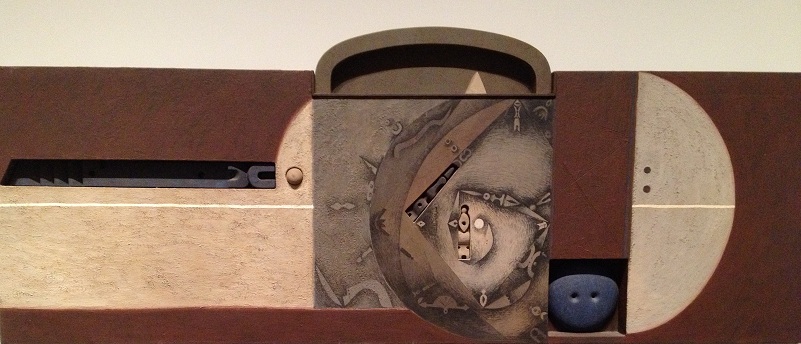
Marcelo Bonevardi
Argentine, 1929-1994
Trap for the Moon , 1967
Acrylic and crayon on textured substrate on canvas with cutouts on wood stretcher; painted wood carving
34 1/4 x 90 x 3 1/2"
Collection of Robert and Mercedes Eichholz

Undated photograph of Marcelo Bonevardi by Edvard Lieber
"There is a small crack through which magic makes itself manifest. To try to seize this with the concrete reality of plasticity is the finality of painting." - Marcelo Bonevardi
COMMENTS
Born in Buenos Aires and raised in Cordoba, Argentina, Marcelo Bonevardi found himself at the center of the New York art world in 1958 as a Guggenheim Fellow. It was here that he saw Joseph Cornell's boxes (at the 1961 Whitney Annual), which served as a major catalyst to the development of Bonevardi's style. However, while Cornell filled his boxes with found objects, Bonevardi painstakingly hand-carved his small wooden figurines and geometric shapes in a prolonged, ritual-like process. In New York, Bonevardi also befriended Julio Alpuy and Gonzalo Fonseca, Uruguayan artists who introduced him to the theories of Constructive Universalism conceived by their master, Joaquin Torres-Garcia.
Trained as an architect, Bonevardi's enigmatic painting-constructions feature carved totemic figures wedged into niches formed in the canvas. As the title of this work suggests, the artist sought to trap the transitory elements of the celestial world in structured, geometric forms. Unlike his contemporaries, Bonevardi's take on Constructivism is not strictly formalist, but marked by the artist's interest in African and pre-Columbian cultures. The artist stated in 1970, "There is a small crack through which magic makes itself manifest. To try to seize this with the concrete reality of plasticity is the finality of painting."
- SBMA Label
